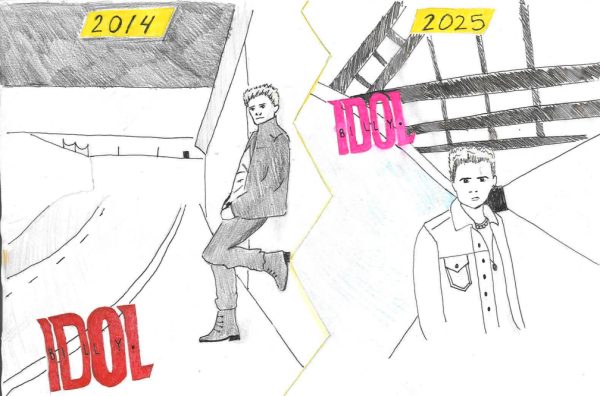Horror finds a new take: digital media
Illustration by Brandon Aguilar Fernandez
YouTube series “The Backroom” used digital horror to capture audience.
Horror can be an acquired taste for some. It connects to elements of fear, which is not an emotion many like to experience. But horror can be used to have fun, not in a typical adventure way but as a thrilling and suspenseful series of shocks and surprises that can also be appreciated and analyzed in a creatively challenging way. It can leave audiences excited to try and predict what can happen next in a story or while playing a game. Like amusement parks, haunted houses and of course, the media, horror films in particular seem to leave many feeling mixed emotions.
Media over the years has popularized the fun of the horror and thriller genres and their ability to capture the audience and leave them at the edge of their seats. Fans hang on to every moment, waiting to find out if the conclusion will be satisfying and something that could stick with them for the next week or two. The true potential of horror media, though, remained out of reach for several years. Even some of he best on-screen frights of old (“The Shining”, “Scream”) don’t fully capture the feeling of an invisible cameraman capturing horrific events in a naturalistic, believable way. But there is a certain type of horror media that has caught on and made it more immersive for the audience, and that is known as digital horror. This is arguably the truest form of horror there is.
Digital horror makes it seem like you aren’t really watching a film but instead watching footage that feels like it has come from the real world. One popular film that did this was “The Blair Witch Project” (1999). Back when this film was about to release, the producers were claiming the film itself was real footage found in the forest, all in an attempt to promote the movie as being real found footage. It felt real because you are told they have found this tape and you are about to watch it. The tape is from the perspective of a person who physically has a camera in the film and shows her time creating a documentary with her friends during the duration of the film until a grim and mysterious end, adding to the realism (not to mention none of the actors were recognizable at the time, which helped as well).
The genre of this film, which some dubbed as “found footage” in the early 2000s (with “Paranormal Activity” being the most successful, if not the most convincing, example), is the best form of horror, in this writer’s opinion. Even if you think the movie is fake, the discourse that results surrounding the veracity of the film just creates more suspense and speculation. The genre finds a way to make you feel like you are a character in the world, and it’s a world where the events you are watching actually happened. With this, more and more movies are trying to be like “The Blair Witch Project”, like “Cloverfield” (2008) and “Grave Encounters” (2011). But the popularity of this genre is no longer restricted to the big screen.
YouTube is a platform that has been uploaded with digital horror videos (sometimes referred to as “creepypasta”) in recent years. But instead of big or even independently financed studios making the videos, it’s now small content creators that are making the story. One example of this is the “Local 58 Series” created by Chris Straub.
Instead of watching a tape of found footage, in this series, you are watching a news story about a strange weather-related terror event in a fictional town, as if you’ve clicked on an old local news broadcast that has been hacked. The series is a great way to start going down the rabbit hole of digital horror in the media since YouTube has tons of content creators making this type of horror.
A popular digital horror series on YouTube that came out recently is “The Mandela Catalogue”, where the plot is similar to “Local 58” but executed differently and features enemies disguised as humans so there is no one to trust. Another popular digital horror series that hit YouTube recently is Kane Pixels’ “The Backroom”, which explores a new dimension that has an environment filled with familiar rooms people feel they have been in before but never actually have. The rooms are filled with antagonists that cannot be defeated easily.
Both of these series execute digital media well since they tell the story of their world without making it look like you are just watching another horror film. The genre is simultaneously both more humanoid and yet still more unusual than most mainstream horror movies. When you watch films like “The Evil Dead” (1981) or “The Cabin in the Woods” (2011), you know it’s not trying to be realistic since they have tons of different camera angles and follow many different characters. Though they do show the horror of the world and are great horror films to watch, they don’t leave the eerie feeling that comes from the “found footage” that might have come from our world. Digital horror will leave you with the feeling that the event you just watched might have actually happened.
Watching digital horror (and its explosive popularity) has created a new world of horror in the media. I would recommend watching series from YouTube content creators since they are more indie and show much more passion for their project. They are also free to watch! “The Gemini Entertainment”, “Local 58”, and “The Walten Files” are a great way to get into the genre. If you like the series, then you can get into digital horror films like “The Blair Witch Project” or “Cloverfield”, which are more ambitious, but again, don’t quite have the magic of a random video of mysterious origin found on the internet.

Brandon Aguilar Fernandez is a new Staff Writer for The Heights Herald interested in the world of entertainment news and pop culture. He enjoys sushi and...







